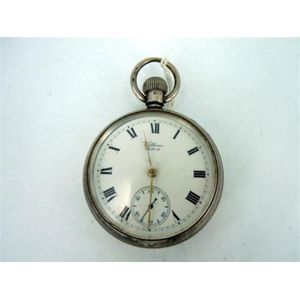Sterling Silver Moonphase Pocket Watch with Repeater
You must be a subscriber, and be logged in to view price and dealer details.
Subscribe Now to view actual auction price for this item
When you subscribe, you have the option of setting the currency in which to display prices to $Au, $US, $NZ or Stg.
- Sterling Silver - Sterling silver is a mixture of 92.5% pure silver and 7.5% of another metal, usually copper. Fine silver is 99.9% pure silver, and is relatively soft and the addition of the very small amount of copper gives the metal enough strength and hardness to be worked into jewellery, decorative and household objects.
- Movement - The technical name for the workings of a clock or watch, and does not include the dial or case.
- Moon Dial - If we imagine life in the 17th century, the only source of ascertaining the time of day or night would have been the local church or municipal clock striking every quarter hour, and able to be heard by all in the village. In England, when longcase clocks became popular and more affordable in the late 17th century, the function of timekeeping and source of time was moved to within the home.
An additional feature on some longcase clocks was to display the phases of the moon, that is the new moon, the full moon and the waning moon over the lunar 29 ½ day cycle. This information was important for farmers for working out cropping schedules; for travellers to know the amount of moonlight on a night they planned to travel; and for those who lived near the sea required knowledge of the tides.
Where included, the moon dial is usually in the form of a disc incorporated into the main dial plate, usually in the arched top section. The lunar cycle starts with the new moon displaying, which is a dark night sky and no man-in-the-moon face being displayed, and then progresses to the full moon face showing on the 15th day of the lunar cycle, and back to no face displaying as the moon wanes. Most lunar dials are partially concealed on each side of their opening in the main dial plate by semi-circular "humps" that allow the painted face to emerge slowly just as the real moon goes out of and back into the earth's shadow.
Nowadays, details of the lunar cycle is published in diaries, almanacs, and newspapers and although some modern longcase clocks are still manufactured with working moon dials, they are more for decoration than for use.
This item has been included into following indexes:
- pocket watches, case type - silver, open face 204
- pocket watches, country - Swiss made 463
-
pocket watches, features
- calendar 26
- repeater / repeating 107
Visually similar items

A silver open faced split dial quarter repeater pocket watch, Volta dial. Swiss case marked 935 silver 32737, 15 jewels, silvered dial, Breguet numbers, crown wind, movement unmarked quarter repeater. Total weight: 73.2 grams

A gun metal open faced pocket watch by Juvenia, gun metal, dial marked Juvenia case Juvenia 12399, cream dial, Arabic numerals, outer tachymeter, gold hands, sub dial, crown wind, movement engraved Juvenia chronographe. Total weight: 54.6 grams

A silver gentleman's pocket watch, Waltham USA; case Dennison watch case Co, Birmingham (date obscured).

A Swiss gold open faced full sized chronograph pocket watch, 18ct yellow gold, case bears Swiss hallmarks Lw 18C/755 (Helvetia)919. Swiss made movement bears mark 'The Winner' split seconds chronograph with Sub dial for Consant seconds and split seconds, t
